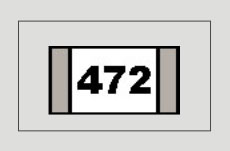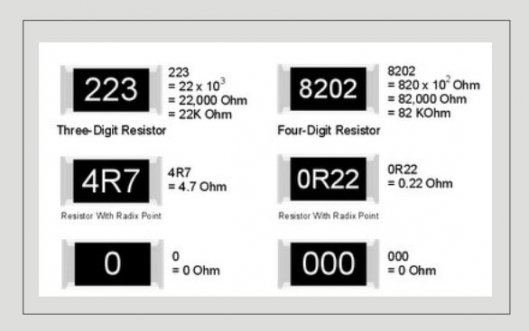SMD resistors are small rectangular shaped components with metalized areas at the ends. The metalized areas are used for soldering with the PCB. The SMD resistor has ceramic substrate on to it a metal oxide film is deposited. The thickness and length of this metal oxide film determines the value of resistance. The use of Metal oxide gives good stability and tolerance to the SMD resistors.Unlike color coded resistors, SMD resistors do not have any color bands instead they have numbers printed on it. It is difficult to identify the SMD resistor if the coding method is not known. Here describes the methods to identify the SMD Resistor.

The SMD resistors are available in different packages. Commonly available packages are 2512, 2010,1812,1210,1206,0805,0603,0402,021 etc. These packages are based on the size of the resistor ranging from 6.30×3.10 to 0.6×0.3 mm. Power rating and tolerance also vary depending on the make.
Marking system
SMD Resistor marking system is mainly used for the replacement of the resistor or fault finding. Many SMD resistors do not have marks on it so that it is difficult to identify them. But some have marks printed on the body for easy identification. There are three marking systems commonly used.

Three figure marking
In 3 figure marking, there are three figures. The first and second figures indicate the significant figures and the third one, is the multiplier. Instead of the color rings, actual number is used in figures. For example, if the SMD resistor has the figures 472, it indicates 4, 7 = 47 x 102 ohms. That is the value is 4.7K.But the resistors marked as 100 is not a 100 ohm resistor but 10×100 = 10 ohms or 10×1 = 10 ohms. In the case of resistors less than 10 ohms, the letter R is used in the position of decimal. For example, 5R6 represents 5.6 Ohms.
3-digit code examples:
220 = 22 × 100 (1) = 22O (not 220O!)
471 = 47 × 101 (10) = 470O
102 = 10 × 102 (100) = 1000O or 1kO
3R3 = 3.3O
Four figure marking
4 Digit markings are used to denote high tolerance SMD resistors. In these resistors, the first, second and third figures represent significant values while the fourth is the multiplier. For example, if the figures are 4702 then the value is 470 x 102 ohms or 47K. In 4 figure marking, the values less than 100 ohms use the letter R at the position of the decimal point.
4-digit code examples:
4700 = 470 × 100 (1) = 470O (not 4700O!)
2001 = 200 × 101 (10) = 2000O or 2kO
1002 = 100 × 102 (100) = 10000O or 10K?
15R0 = 15.0O

EIA 96 marking
EIA 96 marking system is used in resistors with 1% tolerance. In this marking, three character code is used. First and second digits indicate the resistor value and the third character is a letter that indicates the multiplier. For example if the marking is 68X, then X represents 0.1. Figures 68 X can be split into two elements. 68 represent significant figures 499and X represents 0.1. So the value is 499×0.1 = 49.9 ohms.
Other markings include Z(0.001),Y or R(0.01),X or S(0.1),A(1),B or H(10),C(100),D(1000),E(10,000),F(1,00000) etc.
EIA-96 code examples:
01Y = 100 × 0.01 = 1O
68X = 499 × 0.1 = 49.9O
76X = 604 × 0.1 = 60.4O
01A = 100 × 1 = 100O
29B = 196 × 10 = 1.96kO
01C = 100 × 100 = 10kO
Other markings on SMD Resistor
1. SMD resistor with a marking of 0, 00, 000 or 0000 is a jumper or zero ohm link.
2. The SMD resistor marked with the standard 3 digit code and a short bar below the marking denotes a precision of 1% or less .For example: 122 = 1.2kO 1%.
3. SMDs resistors in order of milliohms, made for current sensing applications are often marked with a letter M or m, showing the decimal point location. For example: 1M50 = 1.50mO
4. SMD resistors in current sensing property can also be marked with a long bar on top .For example 1m5 = 1.5mO, R001 = 1mO, etc. or a long bar under the code .For example 101 = 0.101O, 047 = 0.047O. The underline is used when the starting ‘R’ has to be omitted due to the limited space on the resistor’s body.
Filed Under: Electronic Projects


Questions related to this article?
👉Ask and discuss on EDAboard.com and Electro-Tech-Online.com forums.
Tell Us What You Think!!
You must be logged in to post a comment.